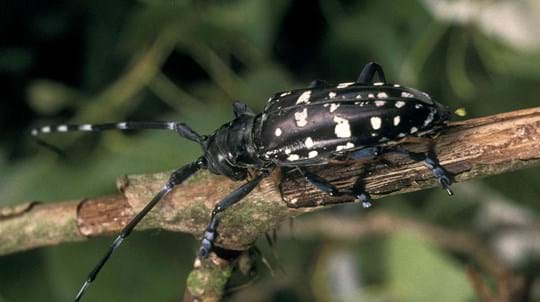
Pests and diseases

Woodland Trust
The Paddock Wood area of Kent was the UK’s first (and only to date) site to have an outbreak of Asian Longhorn Beetle (ALB) back in 2012. Although the source of the pest has never been conclusively determined, the most likely cause was larvae emerging from timber pallets commonly used as wood packaging on stone imports from China. By law, these should be heat-treated at the point of export to destroy all insect larvae, but sometimes that does not happen. The Forestry Commission has targeted communications at stone importers asking them to be vigilant.
Government agencies like the Animal and Plant Health Agency (APHA) take any outbreak incredibly seriously. As a result of the 2012 outbreak, mature trees were removed in the immediate vicinity to ensure that not a single larva was missed. Leaflet drops were also used to ask everyone in the area to be on the lookout.
ALB is of massive concern as its huge wood-boring larvae can kill healthy trees of a wide variety of species that are native or commonly grown in the UK. This gives us a strong imperative to keep it out of our woodlands, forestry plantations and gardens.
Fortunately female beetles don’t fly far from their point of emergence as long as a ready supply of soft timber is available (eg sycamore, acer, poplar, willow, elm and horse chestnut). They often lay eggs on the tree that they themselves emerged from.
Jane Barbrook is APHA’s lead for plant health in the wider environment and, together with regional inspector Bex Mcilhiney, has been managing the response to ALB at Paddock Wood:
“ALB is a real threat to our trees, with surveillance and early detection being key. This increases the chances of delivering a successful eradication programme and in managing the extent and impact of actions taken. As an Observatree priority pest it’s reassuring to know volunteers’ surveillance activities will complement those of APHA. Working together gives us the best chance of preventing ALB from establishing in our gardens, street trees, woodlands and forestry.
I recently visited Paddock Wood and saw some samples from the sycamore tree that was the focus of the 2012 outbreak. This tree was found to contain over 80% of the exit holes and 40% of the live larvae and pupae found during the initial survey. It was originally covered in ivy, which initially hid the extent of the damage. The most diagnostic feature is the presence of perfectly round 1cm diameter exit holes. This is where the larva, after pupating within the tree and becoming an adult, chews its way to the outside world.
I spent quite a lot of time looking at ‘lookalike’ samples of wood with large holes or larval galleries produced by native insect larvae such as the leopard or goat moth. These exit holes tend to be oval, not round as in the case of ALB, and the ‘frass’ (chewed wood) inside the larval galleries looks sooty and soily. ALB larval frass is much drier and looks like rolling tobacco. These native species tend to prefer dead or dying trees and, unlike ALB, would be incapable of killing a healthy tree so are no cause for concern and are not controlled.
Since 2012, the team from the APHA have been organising annual ground surveys of trees in the vicinity of Paddock Wood up to 2km from the source of the original outbreak. Tree climbers are also used to get a good look into the tree canopy to monitor the site for any new outbreaks of the beetle.
Together with a number of colleagues, I spent some time looking at live trees for signs of ALB through binoculars. We started with a ‘training tree’- a living tree that had holes bored to mimic that of ALB. It didn’t take long to see what a hard job this is!
Although the holes are big, on a large tree they are easily hidden. Winter is the easiest time to spot them but even so, within five minutes you have a sore neck from staring upwards. If the sun is out you can only view half of the tree at a time (so as not to get blinded through your binoculars!).
Once you’ve found a hole it’s very hard to direct others back to the same spot and you quickly realise you don’t have the necessary vocabulary. Descriptions can go something like this:
“Start at the main trunk, take the right hand fork, keep going up to the next fork with five branches, then choose the fattest branch and it’s near the top.”
All things added together, the work starts becoming boring. As a group we noticed that within minutes we were distracted, using our binoculars to spot birds and resting our necks by enjoying the bluebells instead.
So even on the ‘training tree’ where we were meant to find all 14 holes, it was hard to spot them. We tried the same exercise surveying in nearby woodland on real trees and the challenge becomes even harder with crossing branches, woodpecker holes etc.
I have huge respect for the APHA teams and tree climbers who patiently survey thousands of trees in the vicinity each winter. They are doing a great job as so far no more ALB adults or larvae have been found since 2012. If no more are found, it’s expected that the outbreak will be declared definitely eradicated by 2018.